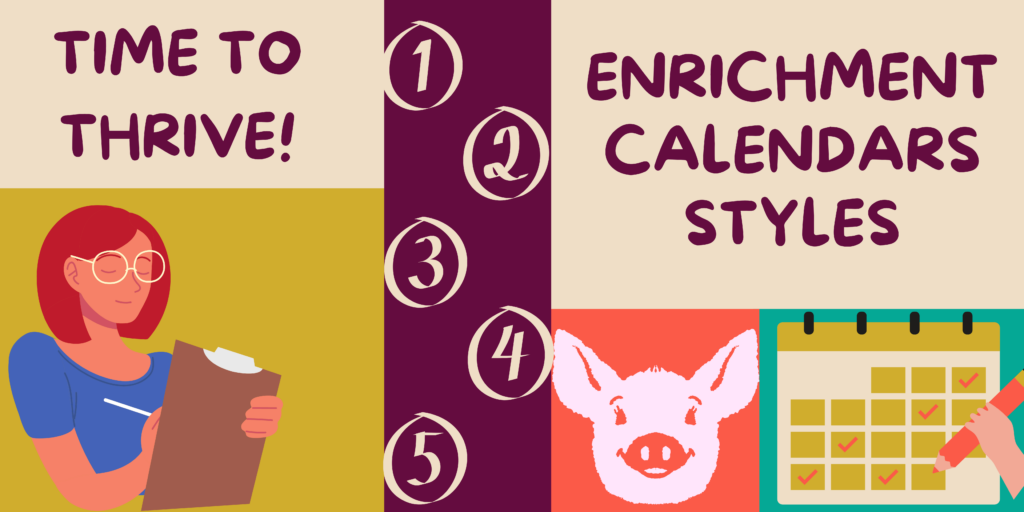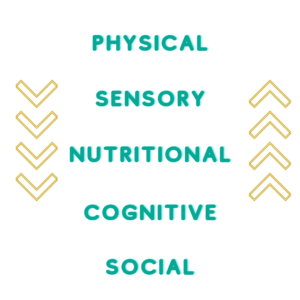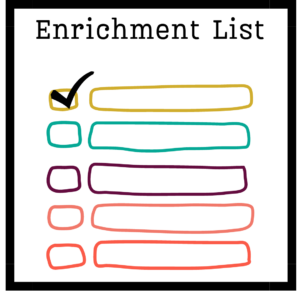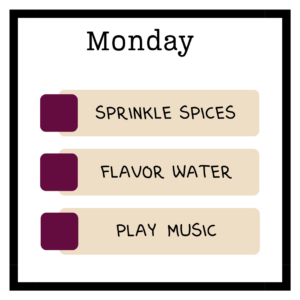
It’s Time To Thrive! So far, this series has covered why enrichment is important, types of enrichment, enrichment considerations for species and individuals, and safety considerations. If you have been following this series, you may feel excited to start. You should be! Enriching the lives of residents is truly what sanctuary is all about. It can be a rewarding experience for staff and volunteers as well. However, starting and maintaining an enrichment program takes some work. This resource looks at calendar styles that will help ensure the success and longevity of a sanctuary enrichment program. How do you organize it? How do you keep track of enrichment that has been done? There isn’t a one size fits all approach. Each sanctuary is different, and what works best for one may not work for another, and that’s okay! We will cover six enrichment calendars with different strategies. Which will work best for you and your care team? Let’s find out!
Enrichment Calendar Styles
Incorporating enrichment into a regular care routine may seem overwhelming, but there are ways to approach it that can make it manageable and even fun! While it may seem hard to get started, exploring and trying out different enrichment calendars can help your enrichment program succeed. The first style of the calendar we will explore is the Fixed Calendar. Is this the one for you?
The Fixed Calendar

The fixed calendar requires mapping out the exact enrichment to be offered for that entire week or month. The enrichment is ideally decided upon by the care staff as a whole, but a care manager or lead caregiverSomeone who provides daily care, specifically for animal residents at an animal sanctuary, shelter, or rescue. could also schedule the enrichment themselves. However, this approach may miss valuable insight from the rest of the team. This approach is practical when there are several new or inexperienced staff or volunteers as it can be set up with this in mind and prevent well-meaning individuals from offering something that might not be appropriate for the individual or resident group.
Enrichment Hacks
To reduce confusion about who gets what, try to schedule the same or similar enrichment activities that use similar ingredients or parts for each species. You could even schedule the same enrichment categories for everyone, though how these are prepared and offered will vary. Another enrichment hack is to use an enrichment item from one healthy resident group in another healthy resident group’s area. The scent of other residents can be a form of enrichment in itself. However, this must be done with care. NEVER share items between residents who are sick or if you have any doubts about their health status.
Random Enrichment Calendar

This one seems pretty straightforward: It’s random! Resident enrichment is randomly chosen at the beginning of the day or week. Doing this at the start of each day has a couple of downsides. One, if you do this at the beginning of the day, it adds one more task to attend to in the early morning when your attention is likely to be more focused on tasks such as feeding and administering medication to residents. The second issue is if you randomly set enrichment at the beginning of the day, you will have to have everything you need for enrichment on hand and time to prep it. If you do it at the beginning of the week or month, you can more efficiently prepare.
To make it truly random, have a care staff enrichment meeting and write a numbered list of at least 14 enrichment options for each group/individual. After this step is done, you can roll the dice. Literally! You can get a few regular dice or purchase a special many-sided game dice. Roll the dice and whatever number you get, match it to the numbered enrichment on the list, and put it on the calendar. You could also search “random number generator” in google and use that instead.

This choice is good if you want an unpredictable enrichment schedule. Over time, residents may pick up on a routine enrichment schedule which can make it less enjoyable. Also, who doesn’t love to roll dice?
Revolving Category Calendar

This strategy lays out the category of enrichment for each day. Within this system, caregivers are free to choose the design of the particular enrichment offered so long as it is in the category of the day. This strategy is an excellent combination of structure and free choice, which can be enjoyable for individual care staff, though it may also be an extra stressor if they have to figure it out mid-shift. With this strategy, you can organize a weekly, bi-weekly, or monthly calendar, allowing caregivers to think of and develop new enrichment possibilities and plan ahead. This can also allow them to prep the enrichment the day before.
The List Calendar

If you love marking things off lists or checking boxes, this may be a good one to try! As the name suggests, caregivers choose from a list of enrichment possibilities. Documentation is essential to ensure the next caregiver doesn’t choose a similar enrichment offering the following day. Writing the date you gave the enrichment next to the item you crossed out or checked off can help ensure the enrichment provided to residents is varied.
The Flex Calendar

The flex calendar is structured but more loosely than a fixed calendar. The setup can be a little time-consuming, but it does offer variations for caregivers to choose from each day. A flex calendar may look like this:
Monday:
- Dried basil is sprinkled near the corner of the outdoor living spaceThe indoor or outdoor area where an animal resident lives, eats, and rests. and on a log
- A cardboard box filled with strawberries and melon slices is provided
- A new log and stump are placed in the outdoor living space
You may find combining the flex calendar with the revolving category calendar easier to prevent confusion and streamline the process. This may look more like this:
Tuesday:
- Smear banana on the exercise ball
- Cut and hang leafy branches from fence post
- Toss full melons into the living space
Wednesday:
- Play calm music in the afternoon
- Put the children’s xylophone in the living space
- Play an instrument
You can see how the above is nicely organized but still leaves room for caregiver discretion, mood, and consideration of things that may come up, preventing one of the things planned from being an option.
Do You Have The Supplies?
Be sure not to add enrichment items to the calendar if you don’t have the resources on hand or a plan to obtain them. For example, if you want to offer paper mache balls to Petunia and Gerry this week/month, you need to be sure you have all the prep items or a plan to procure them. Otherwise, you will get to the day and need to scrabble around for another form of enrichment.
Caregiver’s Choice Calendar

Caregiver’s choice is a fun strategy when you have a cohesive care staff with training, experience, knowledge of natural species/individual behaviors, and good documentation skills. If this sounds like your team, great! Make sure everyone has an understanding of your overall enrichment goals and the importance of documentation and record-keeping. Caregivers will need to pay close attention to what has been given in the last week when choosing the enrichment for that day.
Remember! It Is Only Enriching If…
Different species may react differently when faced with a novel situation or enrichment proffering. This is more so for individuals. Generally speaking, a rich and complex enrichment schedule works best as residents, for example, may quickly become bored with a puzzle feeder they already figured out the week before. However, you may have observed that some individuals are more timid or cautious. For these individuals, you will want to use extra care when introducing particular types of enrichment. Anything which you anticipate could be perceived as a threat should be introduced slowly. It may take them a little while to check it out. However, if you witness fearful or confrontationalBehaviors such as chasing, cornering, biting, kicking, problematic mounting, or otherwise engaging in consistent behavior that may cause mental or physical discomfort or injury to another individual, or using these behaviors to block an individual's access to resources such as food, water, shade, shelter, or other residents. behavior that lasts longer than just an initial surprise, remove the enrichment. Remember, it is only enrichment if they find it enriching, and no one likes to be scared!
Format
Hopefully, one of the above schedule examples sounds like a good fit for your sanctuary. But how do you present it? Many places use whiteboards in highly visible areas for staff to refer to when starting their morning care rounds. If you think a whiteboard may work best in your situation, check out our resource utilizing whiteboards for communication. Others may use laminated enrichment lists or schedules placed on a clipboard in different work areas or even place individual calendars near each resident’s living space. Some may find a shared document or spreadsheet works for them. Whatever works best for you and your team, just remember to update the list as tasks are completed.
We hope this resource helps you find the best enrichment calendar style for your sanctuary. Remember, if you are starting out or have a smaller staff, go with what is easiest for you. You can always make adjustments later. The smoother the transition into making enrichment an aspect of general care, the higher chances of a successful long-term enrichment program.
SOURCES:
6 Calendar Strategies For Enrichment Variation | ZooAn organization where animals, either rescued, bought, borrowed, or bred, are kept, typically for the benefit of human visitor interest. Snippets (Non-Compassionate Source)
Dog Enrichment Schedule | ASPCApro (Non-Compassionate Source)
Development Of An Environmental Enrichment Programme: Case Study Of White Bengal Tiger (Panthera Tigris Bengalensis) And Jaguar (Panthera Onca) At Moscow Zoo | ResearchGate (Non-Compassionate Source)
Non-Compassionate Source?
If a source includes the (Non-Compassionate Source) tag, it means that we do not endorse that particular source’s views about animals, even if some of their insights are valuable from a care perspective. See a more detailed explanation here.








